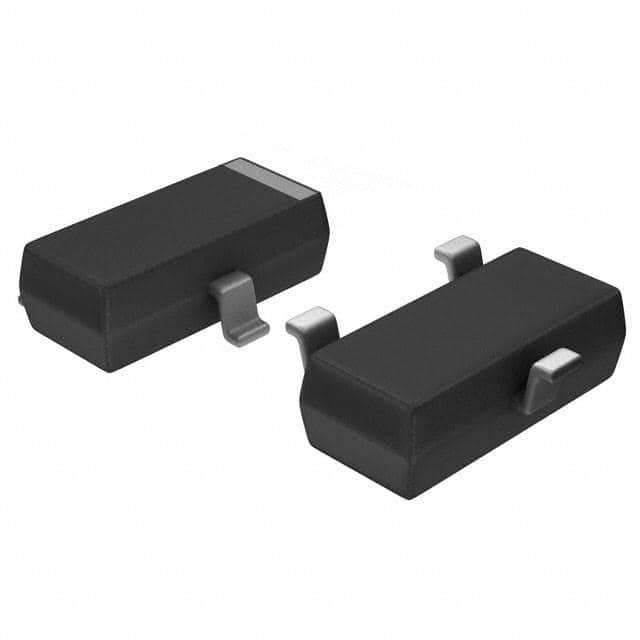ADM1815-10ART-RL7
Product Overview
Category
ADM1815-10ART-RL7 belongs to the category of voltage supervisors or reset ICs.
Use
It is primarily used to monitor the power supply voltage and ensure proper system operation by generating a reset signal when the voltage falls below a certain threshold.
Characteristics
- Voltage monitoring range: 0.9V to 5.5V
- Reset threshold voltage: 1.0V
- Low quiescent current: 6µA (typical)
- Small package size: SOT-23-3
- RoHS compliant
Package and Quantity
ADM1815-10ART-RL7 is available in a small SOT-23-3 package. It is typically sold in reels containing 3000 units.
Specifications
- Supply Voltage Range: 0.9V to 5.5V
- Reset Threshold Voltage: 1.0V
- Reset Timeout Period: Adjustable
- Quiescent Current: 6µA (typical)
- Operating Temperature Range: -40°C to +85°C
- Package Type: SOT-23-3
Pin Configuration
ADM1815-10ART-RL7 has three pins arranged as follows:
```
| | --| RESET |-- --| GND |-- --| VCC |-- |_______| ```
Pin Description: - RESET: Output pin that generates a reset signal when the monitored voltage falls below the threshold. - GND: Ground reference pin. - VCC: Power supply input pin.
Functional Features
- Voltage Monitoring: ADM1815-10ART-RL7 continuously monitors the power supply voltage and compares it with the preset threshold voltage.
- Reset Generation: When the voltage drops below the threshold, the device generates a reset signal to initiate a system reset.
- Adjustable Timeout Period: The reset signal remains active for a programmable period after the voltage rises above the threshold, allowing sufficient time for the system to stabilize.
- Low Quiescent Current: The IC consumes minimal current during operation, ensuring power efficiency.
Advantages and Disadvantages
Advantages
- Wide operating voltage range allows compatibility with various systems.
- Small package size enables space-saving designs.
- Adjustable timeout period provides flexibility in different applications.
- Low quiescent current minimizes power consumption.
Disadvantages
- Fixed reset threshold voltage may not be suitable for all voltage monitoring requirements.
- Limited pin configuration options may restrict certain system designs.
Working Principles
ADM1815-10ART-RL7 operates by comparing the monitored voltage with the preset threshold voltage. When the voltage falls below the threshold, the internal circuitry triggers the RESET pin, generating a reset signal. This signal remains active for a programmable period after the voltage rises above the threshold, allowing the system to stabilize before resuming normal operation.
Application Field Plans
ADM1815-10ART-RL7 finds applications in various electronic systems where reliable voltage monitoring and reset functionality are crucial. Some potential application fields include: 1. Microcontrollers and microprocessors 2. Embedded systems 3. Industrial automation 4. Power management circuits 5. Battery-powered devices 6. Automotive electronics
Alternative Models
There are several alternative models available that offer similar functionality to ADM1815-10ART-RL7. Some notable alternatives include: 1. MAX809: Voltage Supervisors from Maxim Integrated. 2. MCP101: Reset Generators from Microchip Technology. 3. TPS3808: Supply Voltage Supervisors from Texas Instruments. 4. LTC2937: Adjustable Voltage Monitors from Linear Technology.
These alternative models provide a range of options with different specifications and features, allowing designers to choose the most suitable solution for their specific application requirements.
In conclusion, ADM1815-10ART-RL7 is a voltage supervisor IC that offers reliable voltage monitoring and reset functionality. With its compact size, adjustable timeout period, and low quiescent current, it is well-suited for various electronic systems. Designers can also consider alternative models to find the best fit for their specific application needs.
قم بإدراج 10 أسئلة وإجابات شائعة تتعلق بتطبيق ADM1815-10ART-RL7 في الحلول التقنية
Sure! Here are 10 common questions and answers related to the application of ADM1815-10ART-RL7 in technical solutions:
Q: What is the ADM1815-10ART-RL7? A: The ADM1815-10ART-RL7 is a voltage supervisor IC that monitors the power supply voltage and generates a reset signal when the voltage falls below a specified threshold.
Q: What is the operating voltage range of ADM1815-10ART-RL7? A: The operating voltage range of ADM1815-10ART-RL7 is typically between 1.6V and 5.5V.
Q: How does ADM1815-10ART-RL7 help in system reliability? A: ADM1815-10ART-RL7 ensures system reliability by monitoring the power supply voltage and generating a reset signal to prevent the system from operating outside safe voltage levels.
Q: Can ADM1815-10ART-RL7 be used in battery-powered applications? A: Yes, ADM1815-10ART-RL7 can be used in battery-powered applications as it operates within a wide voltage range and consumes low quiescent current.
Q: What is the typical reset threshold voltage of ADM1815-10ART-RL7? A: The typical reset threshold voltage of ADM1815-10ART-RL7 is 1.0V.
Q: Does ADM1815-10ART-RL7 have an adjustable reset threshold voltage? A: No, ADM1815-10ART-RL7 has a fixed reset threshold voltage of 1.0V.
Q: Can ADM1815-10ART-RL7 generate both active-high and active-low reset signals? A: Yes, ADM1815-10ART-RL7 can be configured to generate either an active-high or active-low reset signal based on the application requirements.
Q: What is the typical response time of ADM1815-10ART-RL7? A: The typical response time of ADM1815-10ART-RL7 is 20ms.
Q: Can ADM1815-10ART-RL7 tolerate voltage transients and noise? A: Yes, ADM1815-10ART-RL7 has built-in hysteresis and noise immunity to tolerate voltage transients and noise in the power supply.
Q: Is ADM1815-10ART-RL7 available in a surface-mount package? A: Yes, ADM1815-10ART-RL7 is available in a surface-mount package for easy integration into PCB designs.
Please note that these answers are general and may vary depending on the specific datasheet and application guidelines provided by the manufacturer.


